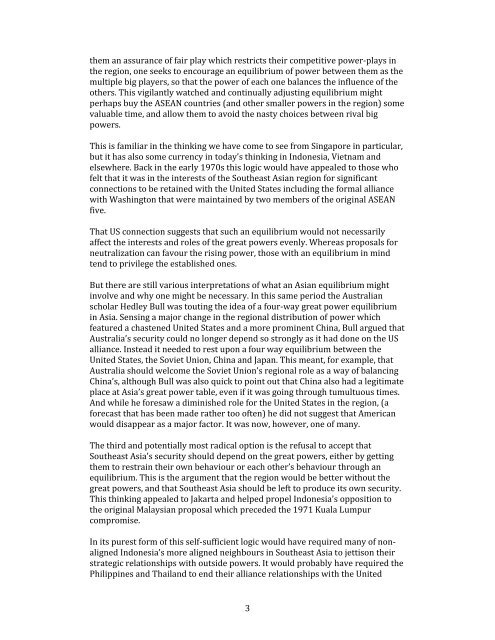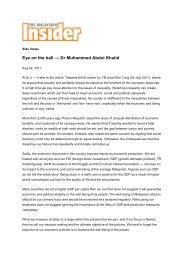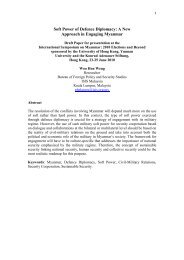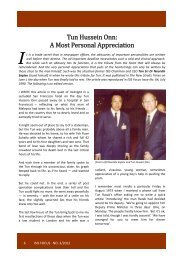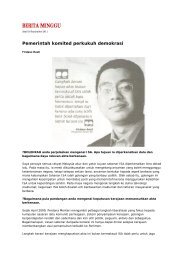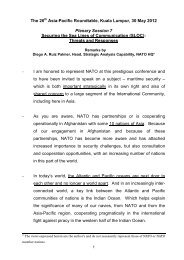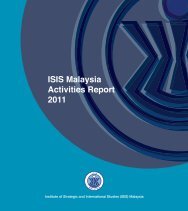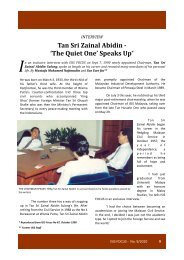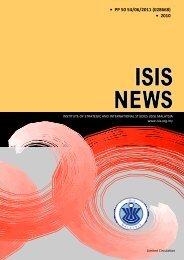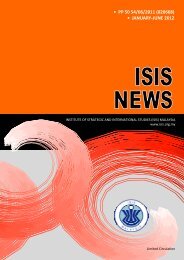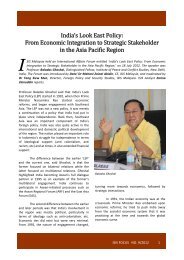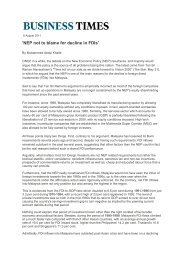ZOPFAN - ISIS Malaysia
ZOPFAN - ISIS Malaysia
ZOPFAN - ISIS Malaysia
You also want an ePaper? Increase the reach of your titles
YUMPU automatically turns print PDFs into web optimized ePapers that Google loves.
them an assurance of fair play which restricts their competitive power‐plays in<br />
the region, one seeks to encourage an equilibrium of power between them as the<br />
multiple big players, so that the power of each one balances the influence of the<br />
others. This vigilantly watched and continually adjusting equilibrium might<br />
perhaps buy the ASEAN countries (and other smaller powers in the region) some<br />
valuable time, and allow them to avoid the nasty choices between rival big<br />
powers.<br />
This is familiar in the thinking we have come to see from Singapore in particular,<br />
but it has also some currency in today’s thinking in Indonesia, Vietnam and<br />
elsewhere. Back in the early 1970s this logic would have appealed to those who<br />
felt that it was in the interests of the Southeast Asian region for significant<br />
connections to be retained with the United States including the formal alliance<br />
with Washington that were maintained by two members of the original ASEAN<br />
five.<br />
That US connection suggests that such an equilibrium would not necessarily<br />
affect the interests and roles of the great powers evenly. Whereas proposals for<br />
neutralization can favour the rising power, those with an equilibrium in mind<br />
tend to privilege the established ones.<br />
But there are still various interpretations of what an Asian equilibrium might<br />
involve and why one might be necessary. In this same period the Australian<br />
scholar Hedley Bull was touting the idea of a four‐way great power equilibrium<br />
in Asia. Sensing a major change in the regional distribution of power which<br />
featured a chastened United States and a more prominent China, Bull argued that<br />
Australia’s security could no longer depend so strongly as it had done on the US<br />
alliance. Instead it needed to rest upon a four way equilibrium between the<br />
United States, the Soviet Union, China and Japan. This meant, for example, that<br />
Australia should welcome the Soviet Union’s regional role as a way of balancing<br />
China’s, although Bull was also quick to point out that China also had a legitimate<br />
place at Asia’s great power table, even if it was going through tumultuous times.<br />
And while he foresaw a diminished role for the United States in the region, (a<br />
forecast that has been made rather too often) he did not suggest that American<br />
would disappear as a major factor. It was now, however, one of many.<br />
The third and potentially most radical option is the refusal to accept that<br />
Southeast Asia’s security should depend on the great powers, either by getting<br />
them to restrain their own behaviour or each other’s behaviour through an<br />
equilibrium. This is the argument that the region would be better without the<br />
great powers, and that Southeast Asia should be left to produce its own security.<br />
This thinking appealed to Jakarta and helped propel Indonesia’s opposition to<br />
the original <strong>Malaysia</strong>n proposal which preceded the 1971 Kuala Lumpur<br />
compromise.<br />
In its purest form of this self‐sufficient logic would have required many of nonaligned<br />
Indonesia’s more aligned neighbours in Southeast Asia to jettison their<br />
strategic relationships with outside powers. It would probably have required the<br />
Philippines and Thailand to end their alliance relationships with the United<br />
3


